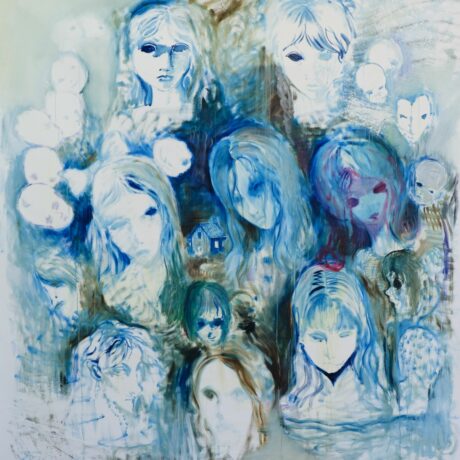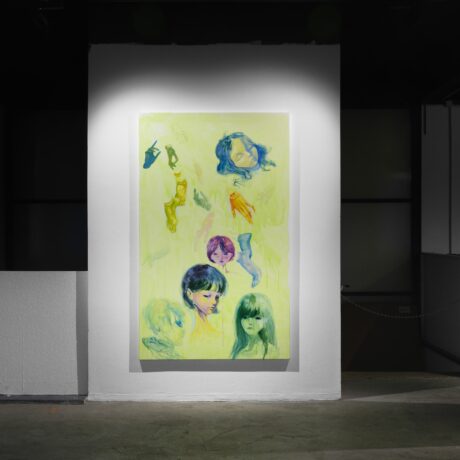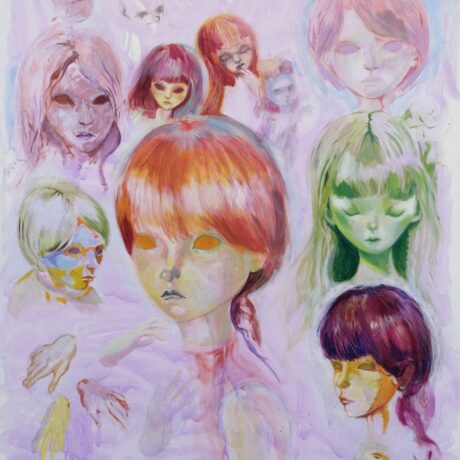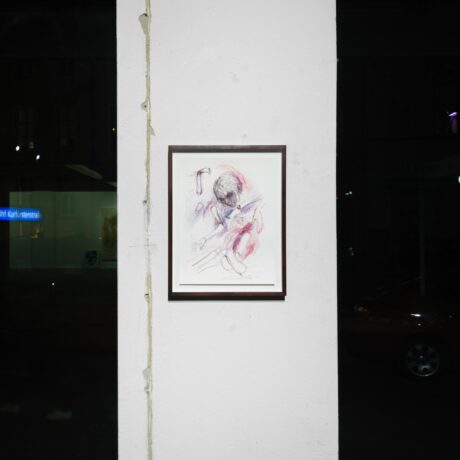Words by Emily Burke
BERLIN- Up until now, it might have been tempting to categorise Will Sheldon as a fetish artist. In 2021, Sheldon earned recognition for his exhibition My Small Super Star, which took place at Heidi Gallery (Berlin), where he introduced us to the seedy underworld of made-to-order dolls with their fragile waists, hip-length hair and vacant eye sockets. This body of work made astute observations on stigmatisation and loneliness, but it was also, at least aesthetically, some good-provocative fun. Given the success of My Small Super Star and Sheldon’s ongoing interest in disreputable subcultures, it would have made sense for him to continue in this ilk. However, his current exhibition at Heidi Gallery, Detached, takes a new direction.
Detached is an abstract contemplation on detachment, but perhaps more importantly, it documents a critical evolution in Sheldon’s artistry. In Detached, his signature airbrushed-iconography is conspicuously absent and is replaced by a scattering of almost Da Vinci-like studies. Detached is on at Heidi until the fifteenth of April (2023), and as this exhibition draws to a close, I spoke with Sheldon about his reflections on the show and what detachment means to him.
EB: Your current exhibition at Heidi in Berlin is titled Detached. Can you talk me through this body of work and explain its relationship to detachment?
WS: Yeah, so the obvious answer is that the show depicts these detached body parts. But this series is really about the studies themselves. I’ve spent a lot of time thinking about sketching and master studies and how to include these in my paintings. I have been inspired by the work of Alberto Giacometti and Erna Rosenstein, who both do these incredible images of floating heads. So I have spent a lot of time looking at these paintings and basically concluding that the studies are the most important aspect of these works and that the painting itself is just a natural consequence of all the effort and detail that goes into the study. Detached also comes from my reflections on this feeling of being separate from myself and this decision that I have made, at times throughout my life, to break off into someone else’s identity. And it’s about how this has felt like the better option for as long as I can remember.
EB: Do the individuals whose personalities you’ve contemplated emulating exist in this exhibition as figures in the paintings?
WS: Some of the figures in the paintings represent the people I would like to live through vicariously. But others represent people like me.
EB: Similarly, in an interview with Katja Horvat in Purple Magazine, you shared a childhood memory of imitating someone else’s handwriting in the hopes of briefly taking on some aspect of their personality. I found this really moving, and it made me reflect on occasions in my own life when I had done something similar. It’s a vulnerable thing to examine. Do you think this is why Detached feels so revealing?
WS: Absolutely. That’s definitely an aspect of why this show feels so vulnerable. But this is also the first show I have ever done using only a paintbrush. I usually show works that are pretty precise, you know? A little more exact. Whereas this show is an exoskeleton of what I’m used to sharing, it shows what is happening underneath, including all of the little mistakes and experiments. I think this comes through as a sort of vulnerability in Detached.
EB: Given that this exhibition is so personal, how has it felt to exhibit it?
WS: This body of work has been a descent into the unknown for me, so it has been both scary and exciting, which comes through in the paintings too.
EB: Can you share some insight into the use of dolls as a recurring theme in your artwork, particularly in your previous series My Small Super Star?
WS: I created My Small Super Star after a period of exclusively painting landscapes. It was a personal mission I set for myself to explore something other than figures, as I was curious about the creative process and challenges of shifting my focus. So when I finally returned to figuration, I thought a lot about the work of artists like Hans Bellmer and Pierre Molinier, who have notoriously done a great deal of work with dolls. I also follow tons of Instagram accounts of ball-jointed dolls because I’m fascinated by the photographs that people take of them. But there is another component of my interest in dolls: I want to avoid dealing with other people, and there is an anti-social side to it that I like. Doll collecting, in general, is considered to be an anti-social behaviour. So it’s a very loaded subject, which is funny because the desire to avoid human interaction is certainly not exclusive to doll collectors. It feels universal. I could ask a friend to model for me, but I like the dynamic of working with a model that does anything I want. It’s fascinating.
EB: As you mentioned, this is a new direction for your work. But I noticed that your characters are still without eyes! It reminds me of something that Jesus says in the bible about the eye being the lamp of the body. Is it significant that your characters are without them?
WS: I like that a lot! It’s funny because I have only just started noticing the lack of eyes in my work. The majority of the artists who I really admire have done something similar in their work, like Hans Bellmer and Maria Lassnig. The same goes for Goya’s Black Paintings and Francis Bacon, who would put a blindfold or shadow over the eyes. So it is something that is explicitly considered in these works. But yeah, it wasn’t something I noticed in my own work until recently. And now, I am paying attention to it and playing with it more.
EB: It’s also interesting to see hands featured so prominently in a show that focuses on your ability to create detailed studies; it feels like a fitting choice.
WS: Yeah, hands are difficult to get right. And I think this is a central focus in Detached because, as you mentioned, the main focus is on the sketching and the studies themselves. And my goal has been to recreate these individual parts of people that capture something about that person as a whole.
EB: Is sketching, as a medium, particularly well-suited for this purpose?
WS: Definitely, I like that the sketch reveals the process of trying to make something perfect. And creating studies allows for a certain degree of experimentation and looseness. But ultimately, I like both because they reveal what is hidden underneath.









